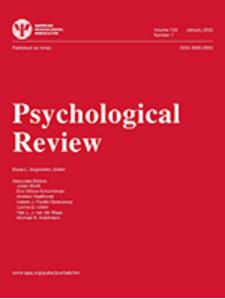灵活的多模式同步理论
IF 5.1
1区 心理学
Q1 PSYCHOLOGY
引用次数: 0
摘要
人际同步是指几个人之间生物行为过程在时间上的协调,关于人际同步的主要理论论述采用的是线性方法,通常将同步视为一种积极状态,并使用总分。然而,众所周知,同步是一种动态形式,其时间轴会不断变化。在许多社会情境中,个体行动与协同行动之间存在着内在的矛盾,因此,持续的一体行动并不总是最佳状态。我们提出了另一种灵活的多模式同步理论,强调情境是定义社会情境中固有的同步 "拉力 "和隔离 "拉力 "的关键要素。然后,类似特质的个体差异和关系变量使个体对这些情境 "拉力 "敏感。通过这种方式,情境、个体差异和关系变量为灵活、动态的同步模式的出现提供了背景,我们认为这种模式在行为、生理和神经等多个方面都具有适应性。我们指出了同步模式的三种后果:社会导向、任务导向和自我导向。考虑到这一理论,我们讨论了在不同情境下出现的多模态关联,并勾勒出该理论的假设。然后,我们提供了两个经验性概念证明:首先,我们展示了在一个新颖的双人运动游戏中,个体差异如何调节情境对同步结果的影响。其次,我们重新分析了之前报告的数据,展示了在测试同步对社会凝聚力的影响时,同步数据分析的 "灵活性 "方法如何提高预测能力。我们还提供了使情境特征标准化的方法以及未来同步研究的指导原则。(PsycInfo Database Record (c) 2024 APA, 版权所有)。本文章由计算机程序翻译,如有差异,请以英文原文为准。
A theory of flexible multimodal synchrony.
Dominant theoretical accounts of interpersonal synchrony, the temporal coordination of biobehavioral processes between several individuals, have employed a linear approach, generally considering synchrony as a positive state, and utilizing aggregate scores. However, synchrony is known to take on a dynamical form with continuous shifts in its timeline. Acting as one continuously, is not always the optimal state, due to an intrinsic tension between individualistic and synergistic forms of action that exist in many social situations. We propose an alternative theory of flexible multimodal synchrony which highlights context as a key component that defines "pulls" toward synchrony and "pulls" toward segregation inherent to the social situation. Traitlike individual differences and relationship variables then sensitize individuals to these contextual "pulls." In this manner, context, individual differences, and relationship variables provide the backdrop to the emergence of flexible and dynamical synchrony patterns, which we consider adaptive, in several modalities-behavioral, physiological, and neural. We point to three consequences of synchrony patterns: social-, task, and self-oriented. We discuss multimodal associations that arise in different contexts considering the theory and delineate hypotheses that emanate from the theory. We then provide two empirical proofs-of-concept: First, we show how individual differences modulate the effect of context on synchrony's outcomes in a novel dyadic motor game. Second, we reanalyze previously reported data, to show how a "flexibility" approach to synchrony data analysis improves predictive ability when testing for synchrony's effects on social cohesion. We provide ways to standardize the characterization of context and guidelines for future synchrony research. (PsycInfo Database Record (c) 2024 APA, all rights reserved).
求助全文
通过发布文献求助,成功后即可免费获取论文全文。
去求助
来源期刊

Psychological review
医学-心理学
CiteScore
9.70
自引率
5.60%
发文量
97
期刊介绍:
Psychological Review publishes articles that make important theoretical contributions to any area of scientific psychology, including systematic evaluation of alternative theories.
 求助内容:
求助内容: 应助结果提醒方式:
应助结果提醒方式:


